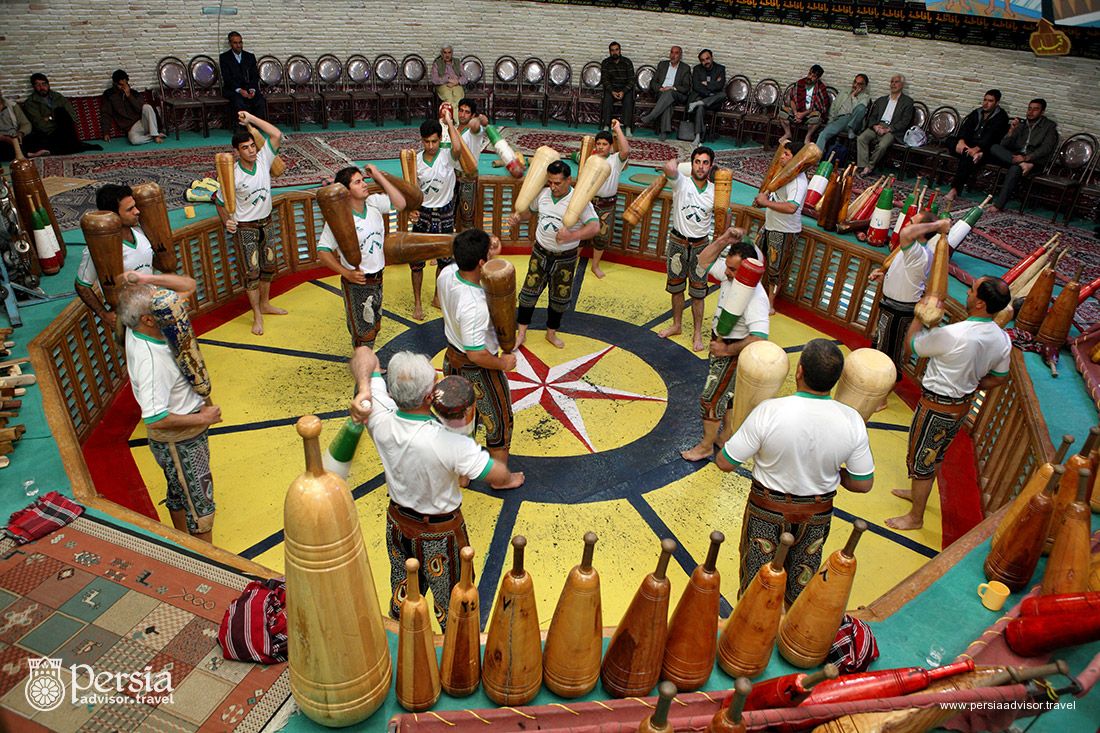
Pahlevani & Zoorkhaneh Rituals
Photo by Vladimir Melnik / Shutterstock
Pahlevani and Zoorkhaneh (literary means house of strength) tradition have their roots in the pre-Islamic era generally and Mithraism particularly. There is a striking resemblance between the architectural structure of Mithraic temples and that of a Zoorkhaneh. For example, the underground location, the central place of the ritual, the stands for the audiences, and the focus on the sky and sun are out of the similarities.
After the advent of Islam and with the increasing popularity of Shiite Islam in Iran, this ancient tradition was influenced such that religious hymns were combined with athletic movements and moreover, Imam Ali was considered an epic athlete and symbol. This sport has also been taught later in neighboring countries such as India, Pakistan, Iraq, and Azerbaijan. Today, the tournaments of this sport are held in the forms of the Asian League and the World League.
Although the nature of this tradition is a sport, the Zoorkhaneh system of training focuses on much deeper matters, in that improving solidarity, patriotism, and modesty is one of its main purposes. The highest title bestowed on athletes in this sport is Pahlavan, emphasizing strong physical health and skills, and on the other hand morality as well.
An athlete will not get the title of Pahlavan unless he becomes an example of moral perfection. The entrance door of Zoorkhaneh is usually lower than the average height so that athletes have to bend to pass through it as a way to remind them of modesty and morality while passing the stages of the physical skills.
Although the nature of this tradition is a sport, the Zoorkhaneh system of training focuses on much deeper matters, in that improving solidarity, patriotism, and modesty is one of its main purposes The highest title bestowed on athletes in this sport is Pahlavan, emphasizing strong physical health and skills, and on the other hand, morality as well.
Zoorkhaneh is a domed chamber, and although made with various styles of architecture and decoration, it has typically three sections including 1) Sardam (a stand where the Morshed (master) sits on and leads the athletes), 2) Goad (a rectangular, octagonal, or hexagonal space in the center that is lower than the surface and athletes perform in it), and 3) stands (where the audiences sit and watch the performance).
The whole scene that takes place in a Zoorkhaneh is a symbolic battle. Sardam is somehow the planning and control room of the whole battle with Morshed who acts as the leader determining the pace of the performance, welcoming athletes to the Goad with epic music and poetry, and announcing the hierarchy of the performers. Morshed must be aware of the rules of the sport, a person who is religious, eloquent speaker, knows music and poetry, and importantly treats everyone equally.

Pahlevani & Zoorkhaneh Rituals
Photo by Fotokon / Shutterstock
The performance starts with Morshed when he asks for the elders’ permission or blessing, and then he takes his place in Sardam, and takes a Persian drum called Zarb. The Morshed’s performance then starts with the name of God and eulogy of the Prophet Muhammad and the Shiite Imams. He then introduces the athletes based on their ranks and invites them to enter the Goad and perform. The introductory ceremony is accompanied by Morshed’s belling and chanting. When the performance of athletes starts, nobody should talk, enter or exit the Zoorkhaneh.
The athletes must wear the custom of the Goad, and enter it only when Morshed has announced their names and allowed them. They should be barehanded and barefooted. There are both team and solo exercises with or without Zarb using various tools including, but not restricted to, metal shields (Sang), (wooden club (Mil), and bow-shaped iron weights )Kabadeh(. The performance bears a resemblance to martial arts.
The athletic aspect of the whole performance is just a part of the social gathering that emphasizes morality, kindness, and philanthropy. For example, an interesting tradition in Zoorkhaneh is “casting of flowers” (Gol Rizan) that is like a public donation ceremony. If one of the members of the community faced a financial problem, the tradition was used in that the audience of the performances in Zoorkhaneh would donate money. If the gathered fund was more than what the person needed, the extra fund was given to a trustable person to be saved for the case of future donations. Pahlevani and Zoorkhaneh ritual was inscribed in 2010 on the UNESCO Representative List of the Intangible Cultural Heritage of Humanity.

